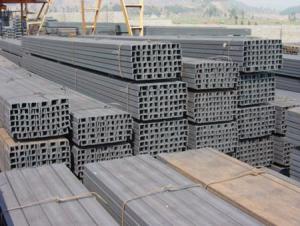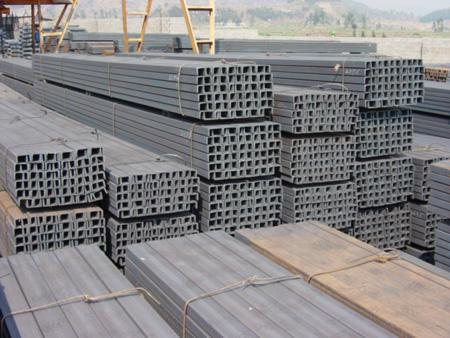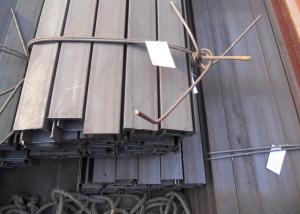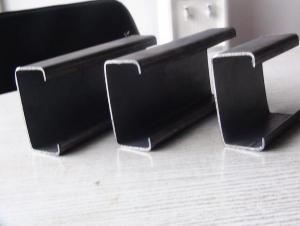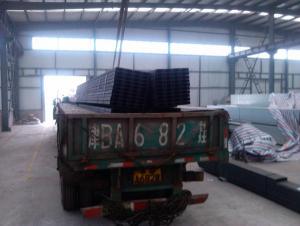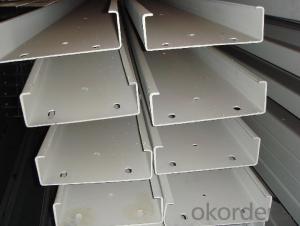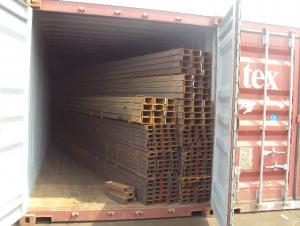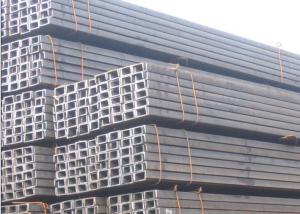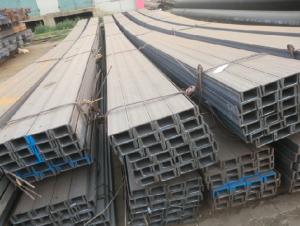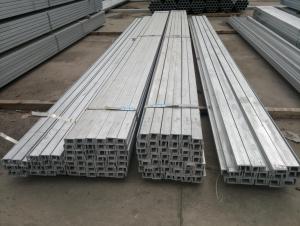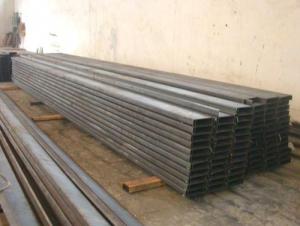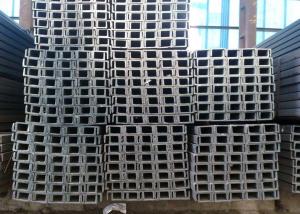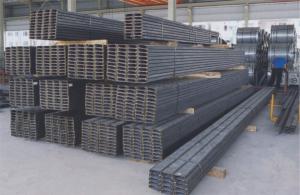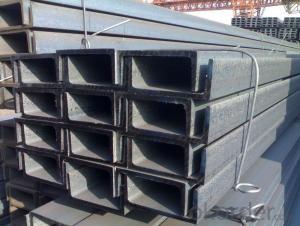GB Channel Steel
- Loading Port:
- China Main Port
- Payment Terms:
- TT OR LC
- Min Order Qty:
- -
- Supply Capability:
- -
OKorder Service Pledge
OKorder Financial Service
You Might Also Like
Specifications of Hot Rolled Channel Steel:
1. We are definitely specializing in manufacturing and supplying channel steel.
| Standard: | GB |
| Material/Grade: | Q235 |
| Sizes: | 50mm to 280mm |
| Sales Volume/Year: | 3000MT |
| Destination Area: | Middle East, Africa, Southeast Asia |
2.Size, Length and Mass.
| Size(mm) | Length(m) | Mass(Kg/m) |
140*58*6.0*9.5 mm | 6m, 12m | 14.535 kg/m |
| 140*60*8.0*9.5 mm | 6m, 12m | 16.733 kg/m |
Package & Delivery of Channel Steel:
The steel u channel will be packed in bundle with steel wire at each end of every bundle and color marking in order to help the customer to recognize his goods more easily at sight.
And steel u channel could be loaded into 20ft or 40ft container, or by bulk cargo. If the weight of each bundle reaches less than 3.5 mt, the loading by break bulk cargo should be choosed. When the weight of each bundle reaches less than 3mt, the loading by container should be choosed.
As for the transportaion from mill to loading port, the truck will be usually used. And the maximum quantity for each truck is 40mt.
All in all, we could do in accordance with customer's request.
If you would like to get our price, please inform us the standard/material, size and quantity. Thank you very much.
- Q: Are steel channels suitable for high-temperature applications?
- Steel channels are generally suitable for high-temperature applications. Steel is known for its strength and ability to withstand high temperatures without losing its structural integrity. However, the suitability of steel channels for high-temperature applications depends on various factors such as the grade of steel used, the specific temperature range, and the duration of exposure to high temperatures. Certain grades of steel, such as stainless steel, are particularly well-suited for high-temperature applications due to their high resistance to corrosion and oxidation. Stainless steel channels are commonly used in industries such as automotive, aerospace, and chemical processing, where they are exposed to elevated temperatures. It is important to consider the specific temperature range when determining the suitability of steel channels for high-temperature applications. Steel begins to lose its strength and structural integrity at higher temperatures. Therefore, it is crucial to select a grade of steel that can withstand the desired temperature range without compromising its performance. Another factor to consider is the duration of exposure to high temperatures. Prolonged exposure to high temperatures can cause steel to undergo structural changes, such as softening or distortion. It is essential to ensure that the steel channels used in high-temperature applications are designed to withstand the expected duration of exposure without any significant deterioration. In summary, steel channels can generally be considered suitable for high-temperature applications. However, it is crucial to select the appropriate grade of steel, consider the specific temperature range, and evaluate the duration of exposure to ensure the desired performance and structural integrity.
- Q: How do steel channels perform under vibration?
- Steel channels exhibit excellent performance when subjected to vibrations due to their high strength and stiffness. The durability and structural integrity of steel channels enable them to withstand dynamic loads and vibrations without experiencing significant deformation or failure. The exceptional properties of steel, including its high modulus of elasticity and superior damping characteristics, aid in absorbing and dissipating the energy generated by vibrations. In applications where resistance to vibrations is crucial, steel channels are commonly utilized, particularly in the construction and transportation industries. They play a vital role in the design of bridges, buildings, and industrial equipment, providing reliable support and stability when subjected to dynamic loads and vibrations. To further enhance their performance in vibrating environments, steel channels can be designed with additional features such as reinforcement ribs or sandwich structures. These design modifications increase their stiffness and damping properties, thereby minimizing vibration amplitudes and reducing the risk of fatigue or failure. Nevertheless, it is important to acknowledge that the performance of steel channels under vibrations can vary depending on several factors, including design, material properties, and the magnitude and frequency of the vibrations. Consequently, proper engineering analysis and design considerations, such as selecting the appropriate steel grade and cross-sectional shape, are crucial to ensure optimal performance and safety in environments prone to vibrations.
- Q: Can steel channels be used for supporting signage and billboards?
- Yes, steel channels can be used for supporting signage and billboards. Steel channels are known for their strength and durability, making them suitable for providing structural support to hold and secure various types of signage and billboards.
- Q: How do steel channels perform in terms of earthquake resistance?
- Steel channels perform well in terms of earthquake resistance due to their high strength and ductility. The structural properties of steel, such as its ability to flex and absorb energy, make steel channels highly resistant to seismic forces. Additionally, steel channels can be designed and reinforced to withstand the dynamic loads and ground motions experienced during an earthquake, making them a reliable choice for seismic-resistant construction.
- Q: Are steel channels suitable for use in the construction of machinery frames?
- Yes, steel channels are suitable for use in the construction of machinery frames. Steel channels provide excellent structural support and stability, making them ideal for handling heavy loads and withstanding vibrations and impacts often encountered in machinery operations. Additionally, steel channels offer versatility in design and can be easily modified or welded to specific requirements, making them a reliable choice for machinery frames.
- Q: What are the different types of steel channel connections for mezzanine floors?
- For mezzanine floors, various steel channel connections are commonly utilized to ensure stability and support for the structure, enabling it to bear the required load. 1. Bolted Connections: Among the most frequently employed steel channel connections in mezzanine floors are bolted connections. These connections involve the utilization of bolts and nuts to join the steel channels together. Bolted connections offer strength and the convenience of easy disassembly and reassembly if necessary. 2. Welded Connections: Welded connections involve welding to join the steel channels together. This connection type provides exceptional strength and rigidity. Welded connections are permanent and not easily disassembled, making them suitable for permanent mezzanine floor structures. 3. Clip Connections: Clip connections are another favored type of steel channel connection for mezzanine floors. These connections utilize clips that securely attach to the steel channels, providing a secure and easy installation. Clip connections are versatile and easily adjustable or modified as needed. 4. Slip-Fit Connections: Slip-fit connections involve inserting one steel channel into another, creating a tight and secure fit. These connections are commonly used when adjustability or expandability is required for the mezzanine floor. Slip-fit connections are simple to install and can be disassembled and reassembled if necessary. 5. Gusset Plate Connections: Gusset plate connections utilize additional steel plates, called gusset plates, to connect the steel channels together. These plates are typically welded or bolted to the steel channels, enhancing the connection's strength and stability. Gusset plate connections are frequently employed in heavy-duty mezzanine floor applications. It is important to consider factors such as load requirements, structural design, and installation preferences when selecting the appropriate steel channel connection for a mezzanine floor. Consulting a structural engineer or professional contractor is advisable to determine the most suitable type of steel channel connection for a specific mezzanine floor project.
- Q: Can steel channels be used in the automotive parts manufacturing industry?
- Indeed, the automotive parts manufacturing industry does utilize steel channels. Within the automotive industry, steel channels find widespread application in structural components, frames, body panels, reinforcements, and chassis parts. Their remarkable strength and durability render them apt for enduring the rigorous conditions and loads confronted by automotive parts. Moreover, steel channels boast the advantage of effortless shaping, cutting, and welding, enabling efficient customization and fabrication of automotive components. By incorporating steel channels, the automotive parts manufacturing industry guarantees the production of sturdy and dependable automotive parts.
- Q: 12# how much is a channel steel? The length is 6 meters. GB steel channel should be used
- The same height of the channel, if there are several different leg width and waist thickness, also need to add a, B, C on the right side of the model to distinguish, such as 25#a, 25#b, 25#c and so on.
- Q: How do steel channels contribute to the stability of a structure during tornadoes?
- Steel channels contribute to the stability of a structure during tornadoes in several ways. Firstly, steel channels are made of high-strength steel, which provides excellent resistance to both compression and tension forces. This strength allows the channels to withstand the powerful winds and forces that tornadoes generate. Moreover, steel channels are often used as structural members in the framing of a building. They are typically installed vertically or horizontally between the main columns and beams, creating a network of interconnected support. This framework helps distribute the load and forces generated by the tornado throughout the structure, preventing concentrated stress points and potential collapses. Additionally, steel channels can be strategically placed in load-bearing walls or as bracing elements to enhance the structural integrity of a building. These channels act as reinforcements, providing extra support and stiffness to the walls, which is crucial during tornadoes when the structure is subjected to intense wind pressures. This reinforcement helps to prevent the walls from buckling or collapsing under the extreme forces. Furthermore, steel channels are often utilized in the construction of storm shelters or safe rooms, which are specifically designed to protect occupants during tornadoes. These channels are incorporated into the walls, ceiling, and floor of these shelters, providing a robust and secure enclosure that can withstand the destructive forces of a tornado. Overall, steel channels play a crucial role in enhancing the stability of a structure during tornadoes. Their high strength, ability to distribute forces, and reinforcement capabilities make them an essential component in ensuring the safety and integrity of buildings in tornado-prone areas.
- Q: How do steel channels contribute to the overall cost-effectiveness of a building?
- Steel channels contribute to the overall cost-effectiveness of a building by providing structural support and reducing the need for excessive materials. These channels are versatile and can be easily fabricated to fit specific requirements, which reduces waste and construction time. Additionally, steel channels have high strength-to-weight ratio, allowing for lighter building designs and lower transportation costs. Their durability and resistance to corrosion also result in long-term cost savings by minimizing maintenance and replacement expenses.
Send your message to us
GB Channel Steel
- Loading Port:
- China Main Port
- Payment Terms:
- TT OR LC
- Min Order Qty:
- -
- Supply Capability:
- -
OKorder Service Pledge
OKorder Financial Service
Similar products
Hot products
Hot Searches
Related keywords
